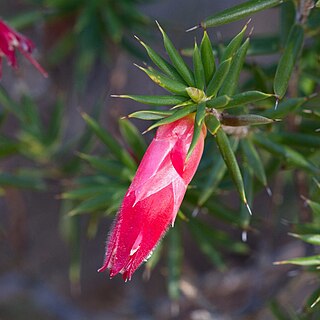
Stenanthera conostephioides, commonly known as flame heath, is a species of small shrub that is endemic to south-eastern continental Australia. It has linear to lance-shaped leaves, red, tubular flowers and green, oval fruit turning dark red.
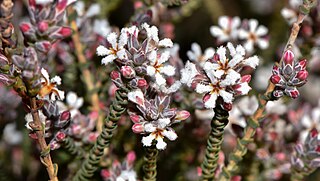
Leucopogon sprengelioides is a species of flowering plant in the family Ericaceae, and is endemic to the south-west of Western Australia. It is an erect shrub with stem-clasping, egg-shaped or lance-shaped leaves and short, dense spikes of white, tube-shaped flowers.

Styphelia planifolia is a species of flowering plant in the heath family Ericaceae and is endemic to the south-west of Western Australia. It is a bushy shrub with narrowly oblong or lance-shaped leaves with a small, sharp point on the tip, and white, tube-shaped flowers.
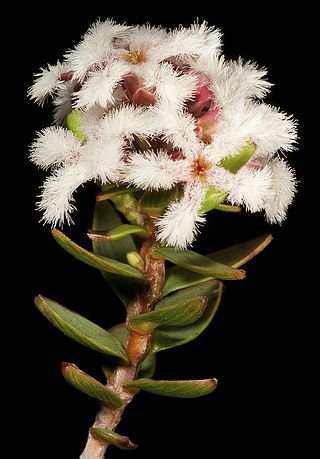
Leucopogon polymorphus is a species of flowering plant in the heath family Ericaceae and is endemic to near-coastal areas of south-western Western Australia. It is a shrub with egg-shaped to lance-shaped or almost linear leaves and short, dense spines of white, tube-shaped flowers.
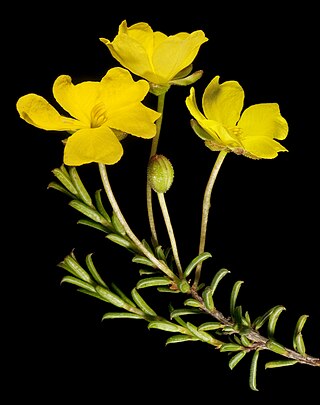
Hibbertia lineata is a species of flowering plant in the family Dilleniaceae and is endemic to the south-west of Western Australia. It is a spreading to erect shrub with linear to narrow egg-shaped leaves and yellow flowers, usually with ten stamens arranged on one side of, and leaning over the two densely hairy carpels.
Lasiopetalum indutum is a species of flowering plant in the family Malvaceae and is endemic to the south-west of Western Australia. It is an erect or straggling shrub with hairy stems and pink, cream-coloured or white flowers.
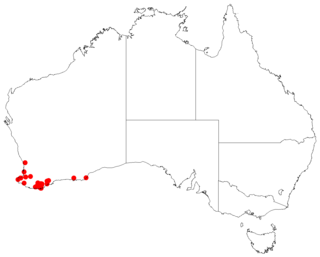
Leucopogon elatior is a species of flowering plant in the heath family Ericaceae and is endemic to the south-west of Western Australia. It is a slender, erect or straggly shrub with broadly egg-shaped leaves, and white, tube-shaped flowers.
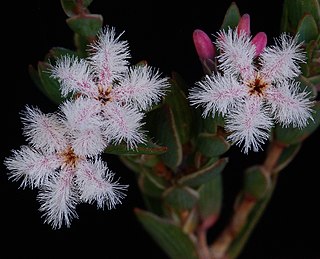
Leucopogon elegans is a species of flowering plant in the heath family Ericaceae and is endemic to the south-west of Western Australia. It is a spreading shrub with egg-shaped leaves, and white or pink, tube-shaped flowers densely bearded on the inside.

Leucopogon flavescens is a species of flowering plant in the heath family Ericaceae and is endemic to the south-west of Western Australia. It is a shrub with oblong leaves and white, tube-shaped flowers that are densely bearded on the inside.
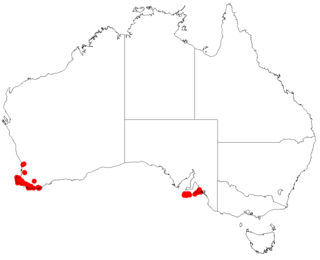
Leucopogon hirsutus is a species of flowering plant in the heath family Ericaceae and is endemic to southern continental Australia. It is a low-lying or straggling shrub with elliptic to oblong leaves and inconspicuous, white, bell-shaped flowers.

Leucopogon lasiophyllus is a species of flowering plant in the heath family Ericaceae and is endemic to the south-west of Western Australia. It is an erect shrub with linear to lance-shaped leaves and small, dense spikes of tube-shaped white flowers on the ends of branches and in leaf axils.

Leucopogon lasiostachyus is a species of flowering plant in the heath family Ericaceae and is endemic to the south-west of Western Australia. It is an erect shrub with egg-shaped to lance-shaped leaves and dense, cylindrical spikes of tube-shaped white flowers on the ends of branches and in leaf axils.

Conostephium preissii is a species of flowering plant in the family Ericaceae and is endemic to the southwest of Western Australia. It is an erect shrub with many stems, egg-shaped to oblong leaves and white and purplish to reddish-pink flowers.
Thomasia rulingioides is a species of flowering plant in the family Malvaceae and is endemic to the south-west of Western Australia. It is an erect, open shrub with densely hairy new growth, narrowly oblong to narrowly egg-shaped leaves with wavy edges, and pink to purple flowers.

Leucopogon obtusatus is a species of flowering plant in the heath family Ericaceae and is endemic to the south-west of Western Australia. It is an erect shrub that typically grows to a height of 0.25–1 m. Its leaves are sessile, egg-shaped to oblong, overlap each other and are about 2 mm (0.079 in) long. The flowers are arranged in short, dense spikes on the ends of branches or in upper leaf axils with leaf-like bracts and broad bracteoles less than half as long as the sepals. The sepals are about 2 mm (0.079 in) long, the petals about 4 mm (0.16 in) long and joined at the base, the lobes shorter than the petal tube.

Leucopogon oppositifolius is a species of flowering plant in the heath family Ericaceae and is endemic to the south of Western Australia. It is a slender, erect to spreading shrub that typically grows to a height of 15–80 cm (5.9–31.5 in). Its leaves are arranged in opposite pairs, narrowly linear to narrowly lance-shaped and 2–4 mm (0.079–0.157 in) long. The flowers are arranged in short spikes on the ends of branches with leaf-like bracts and narrow bracteoles about half as long as the sepals. The sepals are about 2 mm (0.079 in) long and lance-shaped, the petals about 4 mm (0.16 in) long and joined at the base, the lobes about the same length as the petal tube. Flowering mainly occurs from July to December.
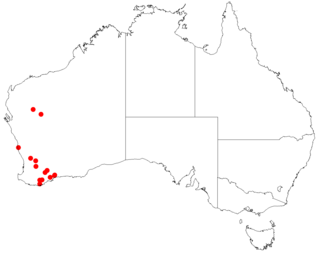
Leucopogon ovalifolius is a species of flowering plant in the heath family Ericaceae and is endemic to the south-west of Western Australia. It is an erect or straggling shrub that typically grows to a height of 1–2 ft (0.30–0.61 m). Its leaves are egg-shaped with the narrower end towards the base, 4.2–6.3 mm (0.17–0.25 in) long and sessile. The flowers are arranged in pairs or threes in leaf axils on a short peduncle with tiny bracts, and bracteoles less than half as long as the sepals. The sepals are about 2 mm (0.079 in) long, the petals 4.2–5.3 mm (0.17–0.21 in) long and joined at the base, the lobes longer than the petal tube.
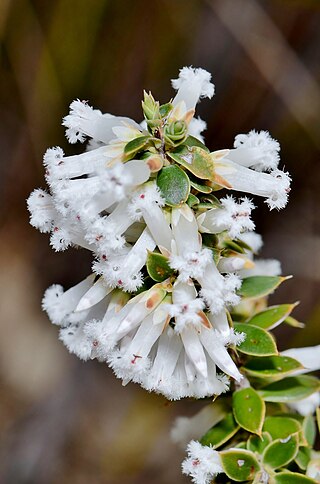
Leucopogon oxycedrus is a species of flowering plant in the heath family Ericaceae and is endemic to the south-west of Western Australia. It is an erect shrub with variably-shaped leaves with a small, sharp point on the tip, and white, pink or red, tube-shaped flowers.

Leucopogon reflexus, commonly known as heart-leaf beard-heath, is a species of flowering plant in the heath family Ericaceae and is endemic to the south-west of Western Australia. It is an erect shrub with small, usually downturned leaves and short, dense spikes of tube-shaped, white flowers.

Leucopogon tetragonus is a species of flowering plant in the family Ericaceae, and is endemic to the south of Western Australia. It is a robust shrub with crowded, often decussate, oblong to lance-shaped leaves and short, dense spikes of white, tube-shaped flowers.



















